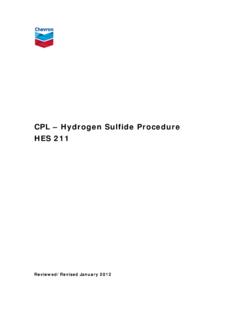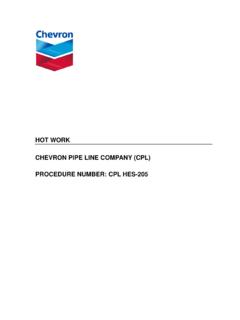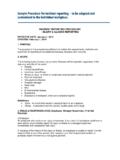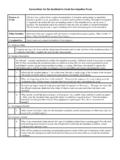Transcription of JOB SAFETY ANALYSIS (JSA) PROCEDURE …
1 JOB SAFETY ANALYSIS (JSA) PROCEDURE NUMBER: HES-208 CPL HES 208 Job SAFETY ANALYSIS Revised & Printed January 2012. Uncontrolled when 2 HES 208 Job SAFETY ANALYSIS CONTENTS Job SAFETY ANALYSIS HES-208 Section Title Page Purpose 208 - 3 Scope 208 - 3 Prerequisites 208 - 3 Process Overview 208 - 4 Instructions 208 - 5 Low-Risk Routine Jobs 208 - 5 High-Risk/Non-Routine Jobs 208 - 6 Roles and Responsibilities 208 - 7 Reporting Requirements 208 - 7 Documentation and Records Retention 208 - 8 Required Documentation for HRNR JSA 208 - 8 Document Storage and Retention Time 208 9 Document Control 208 9 Document List 208 - 9 Appendices A Glossary B Job SAFETY ANALYSIS Form (CPL-208) C Think incident Free (TIF) Form D Hazard Identification Tool CPL HES 208 Job SAFETY ANALYSIS Revised & Printed January 2012.
2 Uncontrolled when 3 HES 208 Job SAFETY ANALYSIS Purpose A Job SAFETY ANALYSIS (JSA) is a critical component of our effort to achieve incident -Free Operations (IFO). It is a tool used to identify and mitigate/eliminate hazards associated with each step of a job. Benefits: When this process is used correctly, it will result in reduced injuries and incidents. It should provide a common understanding to help everyone plan to do the job safely. It also can be used as an effective tool for training all (new and experienced) employees. Scope Personnel and Activities Covered by this PROCEDURE This JSA PROCEDURE applies to all Chevron Pipe Line Company (CPL) employees. The JSA PROCEDURE must be used in all company owned/operated facilities and areas. All contractors working on CPL owned or operated property will use a JSA PROCEDURE that meets the minimum requirements in the Contractor Health, Environment and SAFETY Management (CHESM) process or they will follow this PROCEDURE .
3 Prerequisites All jobs performed at CPL-owned and/or operated facilities/areas will be classified as: Low-Risk and Routine Jobs (LR/RJ) or High Risk and/or Non-Routine Jobs (HR/NRJ). All jobs require that a JSA be conducted before the work begins. The following tools aid in this process: the JSA form (Appendix B) Think incident Free (TIF) card (Appendix C), Hazard Identification Tool (Appendix D), Other guidance tools should be used by employees (EEs) conducting the ANALYSIS to properly identify the hazards associated with each step of the job and the actions necessary to prevent injury or incident . The extent of the ANALYSIS may differ based on the level of risk and/or the complexity (more than one person, Simultaneous Operations [SimOps], permitted activities, etc.) of the job being performed. Additional guidance is provided below.
4 CPL HES 208 Job SAFETY ANALYSIS Revised & Printed January 2012. Uncontrolled when 4 HES 208 Job SAFETY ANALYSIS Process Overview Form JSA TeamCreate new JSA with input from all persons involved in the jobOperations Supervisor or PIC verifies that written JSA has been completedBEGIN WORK/PERFORM JOBIf JOB CONDITIONS CHANGE,STOPAND REVISE JSA AS NECESSARYCONTINUE WORK UNTIL COMPLETES ubmit to Field Team Leader or approvalSubmit to SAFETY Specialist for QA Review SAFETY Specialist submits to Field Team Leader for review and approval prior to entering into libraryInput to LibraryYESNOYESNOHR/NRJNOS ubmit JSA for Library?Field Team LeaderAprpoves?STARTDoes Library JSA exist for the HR/NRJ?Determine if job to be performed is a LR/RJ or a JSA must be performed prior to beginning any Supervisor or PIC verifies written JSA has been completedReview and refresh library JSA onsite with all persons involved in the jobYESIf a Library JSA exists for this LR/RJ, the JSA team may:A) Refresh the JSAB) Create a new JSAC) Perform a mental JSALR/RJOperations Supervisor or PIC, verifies that a written/verbal JSA has been completedPerform JSA on-site with input from all persons involved in the jobBEGIN WORK/PERFORM JOBIf JOB CONDITIONS CHANGE,STOPAND REVISE JSA AS NECESSARYCONTINUE WORK UNTIL COMPLETEF ield Team leader reviews written JSA for approval prior to entering into LibraryENDNote: Classification of work as LR/RJ is at the discretion and approvalof Field Team Leader.
5 The Operations Supervisor has the authority to determine when a written vs. mental/verbal JSA is requiredLR/RJ CPL HES 208 Job SAFETY ANALYSIS Revised & Printed January 2012. Uncontrolled when 5 HES 208 Job SAFETY ANALYSIS Instructions Low-Risk / Routine Jobs Low-Risk / Routine Jobs (LR/RJs) are those jobs in CPL that are considered to have a low risk of injury or incident and tend to be performed routinely. These jobs are not required to be documented on the CPL JSA form. The work teams will identify the jobs in their area that meet this definition. These jobs should be reviewed by the people performing the work and then submitted to the Field Team Leader for approval. The area list of LR/RJs must be maintained in the area files by the SAFETY Specialist . Examples of LR/RJs may include but are not limited to: Department of Transportation (DOT) valve inspections (above ground) Booster Station/Meter Station Checks Transmitter calibrations/Pressure SAFETY Valve (PSV) calibrations Vibration testing on pumps Fire extinguisher inspections Calibrating three-way monitors Line locating Working at a office work station Attending meetings Filing records Using office machines (copy, fax, etc.)
6 Each identified LR/RJ must have a quality JSA conducted prior to beginning the work. These are the basic steps for conducting the JSA: 1. Identify the job (swab launch/receive, product switches, sample changes). 2. Involve the person(s) doing the job and/or other knowledgeable person(s) as needed. 3. Outline or break down the job into key steps (isolation, decommission, load, and launch). 4. Outline the hazards associated with each step (pressure, temp, slips, trips, falls, pinch points etc.). 5. Implement/take actions to eliminate and/or mitigate the identified hazards prior to beginning the job. Individuals/teams performing LR/RJs must: Assure the JSA is performed at the job site prior to beginning the job Review the JSA on site with all affected personnel. Address any changes identified prior to and during the course of the job and take appropriate action.
7 Use available hazards identification tools to perform the JSA. NOTE: If at any time the normal scope of the job or conditions change, the work will be stopped and the ANALYSIS will be updated to include the change. CPL HES 208 Job SAFETY ANALYSIS Revised & Printed January 2012. Uncontrolled when 6 HES 208 Job SAFETY ANALYSIS High-Risk / Non-Routine Jobs High-Risk/Non-Routine Jobs (HR/NRJs) are those jobs in CPL that are considered to have a high risk of injury or incident and/or conducted on a non-routine basis. All HR/NRJs require a new documented JSA or an updated library JSA. Examples of HR/NRJs should Any job done under a permit (safe work, lockout/tagout, confined space entry, hot work, excavation, etc.) include but are not limited to: Any job requiring use of a crane (all equipment used for lifting or hoisting) Any job involving work requiring fall protection Jobs assigned to a Short-Service Employee (SSE) Any job assigned to outside personnel unfamiliar with the job/facility (can be Company or contractor crews) Any job that has an existing CPL Library JSA and has not been approved as a LR/RJ Note: Exception to the above are those listed on the local Field Team Leader list of low risk routine jobs.
8 Field Team leader should maintain a list of those activities that are low risk routine for their areas. Each identified HR/NRJ must have a quality JSA conducted and documented prior to beginning the work. These are the basic steps for conducting the JSA: 1. Identify the job (see examples above). 2. Involve the person(s) doing the job and/or other knowledgeable person(s) as needed. 3. Outline or break down the job into steps (isolation, decommission, load, and launch). 4. Outline the hazards associated with each step (pressure, temp, slips, trips, falls, pinch points, etc.). 5. Implement/take actions to eliminate and/or mitigate the identified hazards. 6. Document the Job SAFETY ANALYSIS on a blank CPL JSA form or an updated CPL Library JSA form. Individuals/teams performing HR/NRJs must: Assure the JSA is performed at the job site prior to beginning the job (see library JSAs below).
9 Review the JSA on site with all affected personnel. Address any changes identified during the course of the job and take appropriate action. Use available hazards recognition tools to perform the JSA. Document the Job SAFETY ANALYSIS on a blank CPL JSA form or an updated CPL Library JSA form. NOTE: If at any time the normal scope of the job or conditions change, the work will be stopped and the ANALYSIS will be updated to include the change. CPL HES 208 Job SAFETY ANALYSIS Revised & Printed January 2012. Uncontrolled when 7 HES 208 Job SAFETY ANALYSIS Roles and Responsibilities CPL Employee(s) The CPL Employee(s) is responsible for: Completing JSA and other associated hazard identification training as required. Conducting a quality JSA prior to beginning work. Documenting the JSA when required. Submitting the JSA form to the SAFETY Specialist after completing the job.
10 Identifying LR/RJs in their work area when required. CPL SAFETY Specialist The CPL SAFETY Specialist is responsible for: Providing area JSA and other hazard identification training. Assessing JSA content and effectiveness during Safe Work Practice Field Reviews. Communicating recommendations for improvement to the process and training to the Area Operations Supervisor. Maintaining all documented CPL JSAs submitted in their assigned area. CPL Field Team Leader The CPL Field Team Leader is responsible for: Supporting the implementation and execution of the JSA PROCEDURE in their assigned area. Communicating results and recommendations of the Safe Work Practice Field Reviews to their team. Reviewing and approving LR/RJ classifications for their assigned area. Reviewing and approving any JSA recommendations (new and/or revisions) for inclusion into the JSA library.






